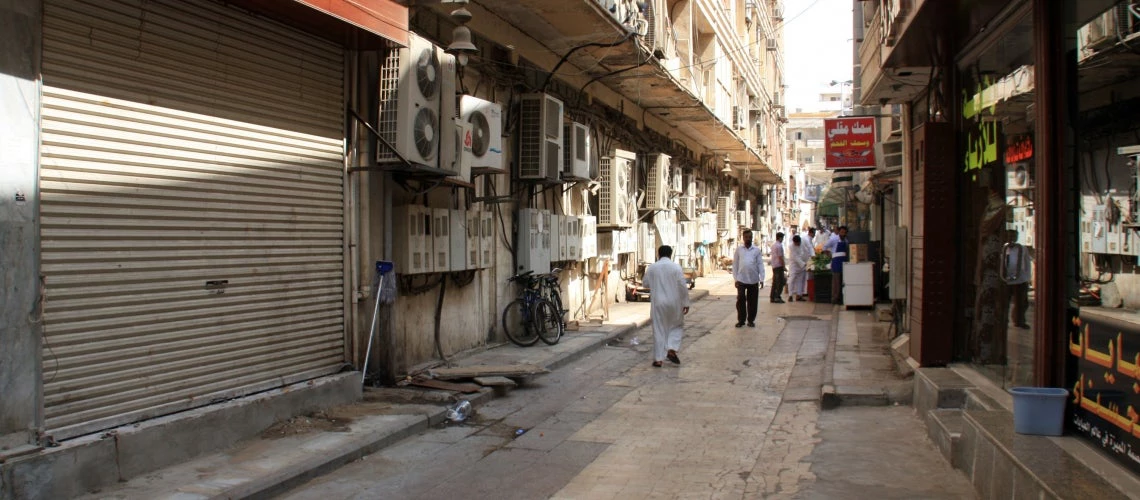 Street in Al-Balad, Jeddah's historic district, Saudi Arabia. © schusterbauer.com / Shutterstock.com
Street in Al-Balad, Jeddah's historic district, Saudi Arabia. © schusterbauer.com / Shutterstock.com
As the world rapidly warms and urbanizes, air conditioning is becoming essential for public health and economic prosperity. ‘Comfort cooling’ is no longer a luxury. It is a necessity.
Rising temperatures reduce labor productivity and increase morbidity and mortality, posing a fundamental threat to human wellbeing. In 2017, 153 billion hours of work was lost to heat. By mid-century, extreme heat is expected to reduce GDP per capita by up to 50 percent in the global south.
Yet while air conditioning can help countries adapt to rising temperatures, it also contributes to global warming. And our needs are only set to rise: space cooling, that is the cooling of interiors, is the fastest growing area of energy use in buildings worldwide and could consume 40% of our remaining carbon budget over the next 30 years.
Most households in hot countries have not yet purchased their first air conditioner (AC): among the 2.8 billion people living in sweltering, low-latitude nations, only 8% have ACs. But this is changing quickly.
AC penetration is set to skyrocket from the current 1.6 billion units in operation now to 5.6 billion units by 2050 as incomes improve in emerging economies. Electricity demand from space cooling will triple according to a recent report from International Energy Agency.
Cooling contributes to climate change by increasing demand for electricity, much of which is still generated from fossil fuels, and through leakage of refrigerants, which have a much higher global warming potential than CO2 emissions. Current cooling technologies rely on man-made fluorinated gasses, or F-gasses, which cause about 2,000-4,000 times more warming than each equivalent unit of carbon dioxide. Left unchecked, F-gases alone could account for 20 percent of climate pollution by 2050.
Following the Montreal Protocol in 1987, the world made great strides in phasing out the production and consumption of hazardous F-gasses such as chlorofluorocarbons (CFCs) and hydrochlorofluorocarbons (HCFCs), and its subsequent Kigali Amendment in 2016 will start to phase-down hydrofluorocarbons (HFCs). Countries are beginning to ban the use of HFCs in certain applications such as mobile air-conditioning.
Air conditioner manufacturers are shifting away from ozone depleting HFCs like R-410A (x2,000 as potent as CO2) to less harmful refrigerants like R-32 (x675 as potent) and R-290 (x3 as potent). Most split residential AC units sold in Southeast Asia now use R-32 for cooling. One company in India has commercialized R-290 cooling and sells about 100,000 per year.
But progress taking new cooling technologies from bench to shelf has not advanced fast enough. Moreover, F-gas alternatives have a major drawback that makes them dangerous to deploy in hot regions. They are highly flammable, can explode at elevated temperatures and ignite easily.
More efficient ACs that run on environmentally-friendly refrigerants will be vital to solve the cooling crunch and mitigate greenhouse gas emissions. In the Middle East and North Africa Region (MNA), the World Bank is making important contributions to this critical work.
MNA countries are already experiencing mean annual temperatures 1.5 ⁰C above pre-industrial levels. Final energy consumption for space cooling in the Middle East has increased by a factor of five over the past three decades from 25 TWh in 1990 to 125 TWh in 2016.
In Saudi Arabia, a recent project supported by the Montreal Protocol’s Multilateral Fund and the World Bank working with the General Authority for Meteorology and Environmental Protection is demonstrating climate-smart air conditioning. The Project prototyped six high-efficiency commercial air-cooled chillers that use refrigerants with a lower global warming potential, supporting the design and demonstration of the viability of large-scale chillers that can efficiently run on R-290 and R-32 at 35 ⁰C, 46 ⁰C, and 52 ⁰C.
Findings from this project will help developing countries with high ambient temperature conditions to have better understanding on the performance and applicability of flammable refrigerants with lower global warming potential as part of their implementation of the Montreal Protocol.
As heat waves become increasingly common, costly, and lethal, this is welcome news. Since the turn of the century, seventeen of the last eighteen years have been the hottest ever recorded. In 2018, extreme heat in the summer in Japan led to more than 22,000 hospitalizations and 80 deaths, and at least 65 people perished when temperatures stayed above 40 ⁰C for several weeks in Pakistan and India. In Algeria, the mercury in Ouargla, a town surrounded by the Sahara, topped 51 ⁰C (124 ⁰F) in July 2018 --- an all-time high for the African continent.
Emerging innovations such as the one spearheaded in Saudi Arabia are bringing direct solutions to our clients.




Join the Conversation